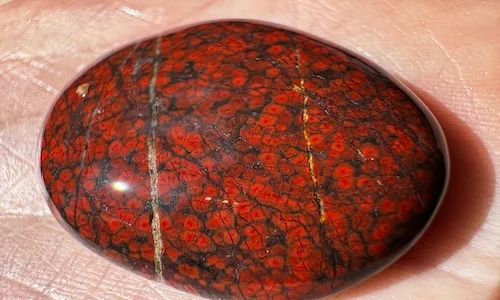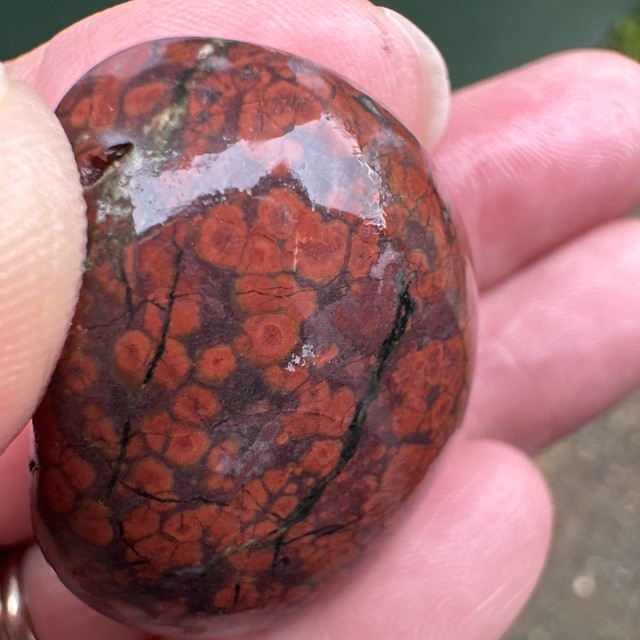Let’s dive into the unique beauty of Gemstone Beach jaspers, which I always keep an eye out for while fossicking.
Types of Jasper
Jasper, along with chert and flint, forms as an opaque variety of silicon dioxide (SiO2) – also known as silica. It usually develops as bands or nodules in sedimentary rocks. For rockhounds like me, jasper is a prized find because of its wide range of colours and patterns.
I’m always on the lookout for red stones, examining nearly every one I pick up. While not all red stones are jasper, and not all jaspers are red, I search for that striking red beauty and the unique characteristics that a Gemstone Beach jasper can reveal!
There are several types of jasper I’ve found, including brecciated jasper and orbicular jasper. Brecciated jasper stands out with its angular fragments, creating fascinating patterns. It appears to “float” in quartz, which gives it a stunning look.
Orbicular jasper, often called “Poppy Jasper,” is prized for its circular designs, resembling vibrant poppy flowers. It’s one of my favorites, though it’s also one of the hardest to find. When I do come across one, it’s usually small and a bit “banged up,” but it always makes my day!
Jasper Colours
The colours of jasper I’ve discovered in New Zealand are just as captivating. They range from deep reds and earthy browns to vibrant greens and soft yellows. Although I don’t find yellows here, my friend Nicola often discovers and cuts beautiful storm jasper, which showcases a stunning yellow. My good friend and fellow rock tumbler, JP, has shared incredible images of limonite prase jasper, known for its earthy brown hues.
Jasper Mixes
Alongside the jasper, I often find various minerals that enhance its beauty and complexity. Quartz frequently appears, contributing to the stone’s hardness and shine. Iron oxides commonly show up, producing the rich reds, browns, and yellows found in many pieces. Calcite occasionally forms within the jasper, creating interesting contrasts.
Other minerals, such as clay, can also be present, influencing the texture and appearance. Sometimes, trace amounts of silicate minerals like feldspar or mica add subtle variations in colour and lustre.
Batch 84: 4lb Tumbler 2
Originally 92 stones (collected from #1 fossick with JP, 14 Sept) were tumbled in F60grit for 12 days. Only 69 of those stones were ready to move onto Stage 2. There were a number of stones in the 220grit redo drawer so those were added to the 69 to make up the load for Batch 84. The rest of the 92 stones went into the Stage 1 redo drawer.
Stage 2: 220grit
Number of Stones: 69+19+6+63=157
Weight in: 1858g
4 Tbspns of 220grit
No Borax
Small ceramic media added
Days Tumbling: 11
Weight out: 1618g – loss of 240 grams
Stage 3: 400grit
Number of Stones: 157
Weight in: 1618g
4 Tbspns of 400grit
No Borax
Plastic pellets added
Days Tumbling: 10
Weight out: 1466g – loss of 152 grams
Pre-polish Clean
Number of Stones: 157
2 tspns grated sunlight soap + water + plastic pellets
Days Tumbling: 2
Batch 84: Added to Stage 2
Batch 84: Also Added Stage 2
Batch 84: After Stage 3
Ready to Polish
Stage 4: Polish Mix
Number of Stones: 157
Weight in: 1466g
Polish Mix (3rd use): Already mixed.
Plastic Pellets added for cushioning
Days Tumbling: 10
Stage 5: Burnish
2 Tbspns borax + water + plastic pellets
Days Burnishing: 11 (yikes!)
Somehow Batch 84 got “forgotten”. I hadn’t written it up in the notebook diary (which I do sometimes when I get sidetracked or am in a hurry). This batch ended up spending 11 days spinning in borax. It did not make them shine any better than if they had only done three days so at least I know now that three days burnishing is enough!
The stones lost about 3grams in volume (weigh: 1463grams).
Polish Complete
Polished Stones of Interest: Batch 84
There were so many interesting stones to choose from in Batch 84. I wouldn’t say it was the best polish finish ever but the general results/shine are pleasing.
Batch 84 | 4lb Tumbler 2 | Gemstone Beach | 7 September – 2 November 2024




























